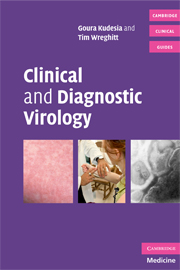Book contents
- Frontmatter
- Contents
- List of plates
- Preface
- Acknowledgements
- SECTION 1 INDIVIDUAL VIRUSES
- SECTION 2 OTHER RELATED AGENTS
- SECTION 3 CLINICAL SYNDROMES
- 32 Central nervous system viral infections
- 33 Viral eye infections
- 34 The common cold
- 35 Respiratory virus infections
- 36 Atypical pneumonia
- 37 Gastroenteritis viruses
- 38 Viral hepatitis
- Chapter 39 Genital tract and sexually transmitted infections (STIs)
- 40 Glandular fever-type illness
- 41 Viral rashes and skin infections
- 42 Infections in pregnancy, congenital and neonatal infections
- 43 Virus infections in immunocompromised patients
- 44 Viral malignancies
- 45 Travel-related infections
- SECTION 4 DIAGNOSTIC TECHNIQUES
- SECTION 5 PATIENT MANAGEMENT
- Index
- Plate section
44 - Viral malignancies
Published online by Cambridge University Press: 07 December 2009
- Frontmatter
- Contents
- List of plates
- Preface
- Acknowledgements
- SECTION 1 INDIVIDUAL VIRUSES
- SECTION 2 OTHER RELATED AGENTS
- SECTION 3 CLINICAL SYNDROMES
- 32 Central nervous system viral infections
- 33 Viral eye infections
- 34 The common cold
- 35 Respiratory virus infections
- 36 Atypical pneumonia
- 37 Gastroenteritis viruses
- 38 Viral hepatitis
- Chapter 39 Genital tract and sexually transmitted infections (STIs)
- 40 Glandular fever-type illness
- 41 Viral rashes and skin infections
- 42 Infections in pregnancy, congenital and neonatal infections
- 43 Virus infections in immunocompromised patients
- 44 Viral malignancies
- 45 Travel-related infections
- SECTION 4 DIAGNOSTIC TECHNIQUES
- SECTION 5 PATIENT MANAGEMENT
- Index
- Plate section
Summary
Cell growth, differentiation and death are controlled by genes. Mechanisms are needed for both stimulating and suppressing growth. Breakdown in the mechanism for control of cell growth leads to uncontrolled growth and malignancy. There are many ways in which cells may lose this genetic control, viral infections being one of those. Not all viruses are oncogenic (e.g. able to induce cancer). It is mainly, though not exclusively, the DNA viruses that have this potential. Human T-cell leukaemia virus types 1 and 2, and hepatitis C virus are examples of RNA viruses that are able to induce malignancy.
How do viruses cause cancer?
There are several mechanisms by which this may occur.
Some viruses, such as HTLV 1, possess a viral oncogene or v-onc gene. Integration of viral genome into the infected cell enables the v-onc gene to be activated. Products of this activated v-onc gene are able to transform the cell by affecting the function of cellular products normally responsible for cell growth. It is believed that v-onc genes have been acquired by viruses through capturing cellular gene material during the process of evolution.
Oncogenes are not unique to viruses, they also form part of the normal cellular genetic material. Cellular oncogenes are different in their structure to v-onc and are referred to as c-onc to differentiate them from viral oncogenes. The c-onc products are required for normal cell activities.
Mutation in the c-onc gene is an important mechanism for cell transformation.
- Type
- Chapter
- Information
- Clinical and Diagnostic Virology , pp. 193 - 197Publisher: Cambridge University PressPrint publication year: 2009



